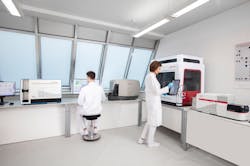Working in tandem with automation in the pharma lab
When the need for precision intersects with monotonous tasks, automated processes can often reduce some common safety risks in lab environments – dropped samples, accidental exposure to biohazards, repetitive-motion injuries, and more. Technology can not only decrease these risks, but can also reduce wasted time and resources. But for that to happen, it’s necessary to optimize workflows to achieve the right balance.
Simply adding automation won’t magically reform an underperforming labor-intensive workflow; instead, an update must begin with evaluating the distribution of labor and considering all the tasks machines can execute. One must set aside the thinking of “the way we’ve always done it” in order to reap the benefits automation can bring.
Take stem cell analysis and transplantation workflows for example. Using automation to approach this workflow can reduce up to 95% of manual steps, shrinking hands-on time from 6 minutes and 23 seconds to just 20 seconds. This can also alleviate up to 87.5% of error-prone steps. This combination can help reduce the overall turnaround time for sample preparation by up to 6 hours a week for the average lab processing 10 samples a day.
Manual workflow challenges
With manual workflows, lab technicians are vulnerable to repetitive-motion disorders caused by too many repetitions of a motion or activity. Daily lab work that might cause arm and hand exertion includes pipetting, handling microscopes, test tube handling, labeling pipe tubes, and data entry. The repeated wrist twisting required for these tasks can cause median nerve compression, leading to carpal tunnel syndrome.
According to the National Safety Council, the private sector reported 247,620 musculoskeletal disorders in 2020. Workers who suffered ergonomic injuries such as bursitis, tendonitis, and trigger finger were off work for an average of 14 days per year. The Centers for Disease Control reports those with CTS can be off work up to 25 days.
Automation can add a valuable solution to reduce this repeated physical strain on staff, along with potential disruptions to the lab. Giving scientists additional time for more valuable tasks and projects about which they are passionate can also improve morale. When professionals spend time and energy doing the work they enjoy, job satisfaction goes up and staff turnover goes down.
Functional technology
We cannot forget that so many of the samples lab staff come in contact with are biohazardous. A cracked or dropped sample can significantly risk the health of lab staff, but that doesn’t have to be the case. For example, a clinical flow cytometry lab can instead use closed primary blood tubes, where automation is able to combine sample preparation and analysis to process the closed sample using cap-piercing technology. For lab staff, this load-and-go workflow can mean significantly less exposure to potential biohazards when handling samples for contagious diseases.
Machines can also be programmed to generate essential data points and transmit them to numerous users or a laboratory information system. Moving away from paper-based data collection systems can also eliminate more opportunities for human errors related to data entry, such as transposing numbers or forgetting a data set. And in the regulatory world, a direct connection to the digital system makes it significantly easier to pull reports and present data.
We must also consider the potential for errors that can come with manual workflows. In addition to the physical strain mentioned previously, repetitive tasks can contribute to both muscle and mental fatigue of lab staff. This can create a host of unpleasant scenarios, from over- or under-processing a sample, to adding the wrong reagent, or possibly even transcription errors – all of which can cost labs precious time and money.
Critical need to support lab staff
As we plan for the future, statistics tell us now is the time to make critical changes to lab workflows. No industry is immune from staffing challenges, and the need for lab technicians is growing at a rate of 11% — faster than the average rate of 8% for most all other jobs in the U.S.
One reason for this trend is the extended life expectancy of U.S. citizens, which is accompanied by an increasing number of people suffering from chronic conditions that require monitoring. This places a greater demand on clinical labs to perform diagnostic tests. Making lab staff workloads more manageable and appealing can only help in filling this critical staffing need.
Machines can perform tasks and generate data, but people, not machines, will develop a new assay and plan experiments, potentially leading to that next big breakthrough. Automation can’t replace trained and dedicated lab staff; it is instead designed to support them and their work, while making them more effective in their role.
